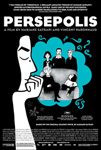Persepolis
Posted on December 24, 2007 at 5:55 pm
A-| Lowest Recommended Age: | High School |
| MPAA Rating: | Rated PG-13 for mature thematic material including violent images, sexual references, language and brief drug content. |
| Profanity: | Some strong language |
| Alcohol/ Drugs: | Drugs, drinking, smoking |
| Violence/ Scariness: | References to wartime violence, torture and execution of prisoners, sad (offscreen) deaths, characters in peril |
| Diversity Issues: | Gender, religious, and ethnic diversity a theme of the movie |
| Date Released to Theaters: | December 25, 2007 |
 Marjane Satrapi brings her award-winning graphic memoir to the screen in a powerful story of growing up in Iran as the Shah was ousted and hopes for democracy were crushed by the rise of the fundamentalists. Named for the legendary ruin Alexander the Great is believed to have burned, the frank portrayal of Satrapi’s coming of age personally and politically is a stunning achievement. Like the books, it is told almost entirely in black and white, with simple, supple, strong lines that beautifully complement and underscore the starkness of the story.
Marjane Satrapi brings her award-winning graphic memoir to the screen in a powerful story of growing up in Iran as the Shah was ousted and hopes for democracy were crushed by the rise of the fundamentalists. Named for the legendary ruin Alexander the Great is believed to have burned, the frank portrayal of Satrapi’s coming of age personally and politically is a stunning achievement. Like the books, it is told almost entirely in black and white, with simple, supple, strong lines that beautifully complement and underscore the starkness of the story.
As a little girl, Satrapi believed what she was told in school and dreamed of becoming a prophet. But when the Shah fell, the children were told to tear his picture out of their textbooks. A beloved uncle was released from prison, and she began to learn for the first time to question what she had been told. The Shah had not been selected by God. He had taken over with the help of America and its oil companies. A brief moment of hope following his overthrow was shattered when the Islamic fundamentalists took over and banned any trappings of Western decadence. In one scene, Satrapi defiantly wears a jacket that says “Punk is not Ded” and is almost arrested for buying rock music and wearing a Michael Jackson button. And the beloved uncle is returned to prison, and then executed.
Satrapi’s parents want her to be free and they know that her outspoken comments will get her into trouble. So they send her to school in Vienna, where she is shuttled from home to home and tries to fit in. She falls in love — and when he betrays her, with the cartoonist’s best revenge, she literally redraws the boy who once looked like Adonis into a pustule-faced buffoon. She is heartbroken, but she puts it into perspective. “I had lived through a revolution that had cost me part of my family. I had survived a war. But a banal love story had almost killed me.”
She returns to Iran, but has to leave again. This time, her parents tell her not to come back.
The film is extraordinary, expanding the forms of memoir and of animation, told with enormous insight into the most intimate moments of adolescent longing and the most complex aspects of political upheaval.
Parents should know that this film includes the portrayal of the fall of the Shah, the Iran-Iraq war, and the rise of the Islamic Republic government. There are references to torture and execution of prisoners and sad (offscreen) deaths and characters in peril. Characters drink, smoke, and (briefly) use drugs and there are some sexual references and non-explicit situations. Characters use some strong language. A strength of the movie is the portrayal of gender, ethnic, and religious discrimination and the way the movie itself takes on stereotypes beginning with its dialogue in French.
Families who see this movie should talk about why Marjane’s parents sent her away and why she wanted to come back.
Families who appreciate this film should read the book and other outstanding graphic memoirs like Fun Home: A Family Tragicomic
and Maus
. They will also appreciate unusual animated films like The Triplets of Belleville
. And, they will enjoy this interview with the author/screenwriter.
